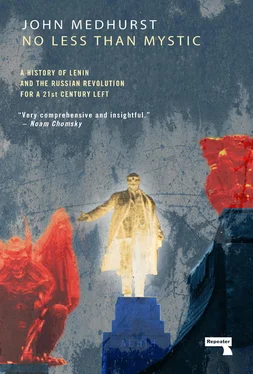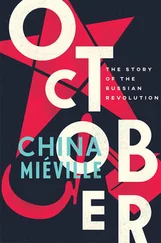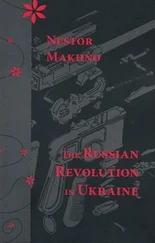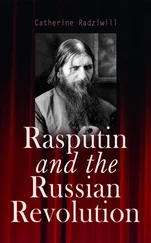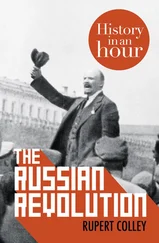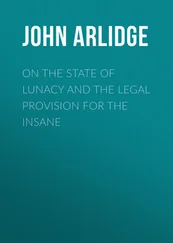After the government moved to Moscow for greater safety, Petrograd began to resemble a ghost town in which the shops were boarded up, the factories barely functioned and weeds grew between the cracks of the pavements. Vera Broido, a child at the time, recalls that the city “bore a drained, hushed look”. 18Lights were turned on for only a few hours a day. There was no heat. Refuse was uncollected. Sewers and pipes cracked and broke, spreading cholera and typhus. With peasant food production disrupted by the Civil War and the rail network virtually destroyed, food deliveries to the cities almost came to a halt. In 1919 the “Petrocommune” cafeterias fed over 600,000 desperate people, but it was thin gruel in every sense of the word. Horses, cats and dogs disappeared from the cities of the north, all fed into what became known as “civil war sausage”. 19A mass exodus began, with both bourgeoisie and workers seeking whatever sanctuary could be found in the countryside. By 1919 Petrograd’s population was a quarter of what it had been in 1914.
In these circumstances the Bolshevik government had only two options–concede complete defeat and withdraw, or move to mass forcible requisition of the grain and food supplies they needed from the countryside. This had started almost from the day they took power. On 27th October, 1917 a “supply detachment” of 500 Kronstadt sailors was sent outside the city to secure food. Within a month the number of workers involved in these detachments had risen to 7,000. 20Early in the new year Sovnarcom created a Supreme Supply Council. In April 1918 the People’s Commissar for Supply instructed local committees to record transit and distribution of food every ten days and take initial steps to intervene if they suspected hoarding of supplies.
On 9th May, 1918, as the first pangs of famine in the cities began to bite, Sovnarcom issued a “Decree to confer on the People’s Commissariat of Supply extraordinary powers for the struggle with the rural bourgeoisie which conceals grain stocks and speculates in them”. The decree’s purpose was to “recognise the necessity of continuing a merciless fight against the bread speculators and bagmen and of compelling every possessor of surplus grain to declare within a week from the promulgation of this resolution in the Volost that he is ready to hand over all in excess of what he needs”. It made clear that anyone not abiding by the Decree would be “handed over to the Revolutionary Court to be sentenced to prison for a term of not less than ten years”. The supply detachments had authority “To use armed force in cases of resistance to the requisition of grain and other food products”. 21
On 18th May Sverdlov candidly announced to the Soviet Central Executive Committee the aim of the policy. Claiming that “revolutionary Soviet authority” was strong in the cities, he admitted it was less so in the villages. “For that reason we must seriously confront the question of the differentiation of the village, the question of creating in the village two contrasting and hostile forces”, he said.
Only if we succeed in splitting the village into two irreconcilably hostile camps, if we are able to enflame there the civil war that occurred not so long ago in the cities […] only then will we be in a position to say that we will do in relation to the village that we were able to do for the city. 22
By this policy Sovnarcom aimed to create social divisions in the village in order to build up its power base there and loosen that of the SRS.
But the Russian village did not conform to Bolshevik ideology. There were hardly any “rich peasants” left. If they were genuinely rich, they became merchants in the towns. There was some differentiation, i.e. peasants who owned more fields than others, but often within the same family or kinship network. Lenin was driven by the idée fixe he had held of the penetration of capitalism into the Russian rural economy since he wrote The Development of Capitalism in Russia in 1899 , a work loaded with specific statistics to prove a thesis he knew in advance was true. Had he looked instead at the data of the 1917 agrarian census (published by the Soviet government itself in 1929), he would have found that only about 2% of rural households, excluding the landed estates, employed hired labour, and that was mostly one hired hand rather than servants or a workforce. 23
Once the state grain monopoly was announced, Sovnarcom sent out armed supply detachments to villages and towns to expropriate “hoarded” grain and food supplies. Lenin wanted a “reliable workers’ army” from Petrograd to launch “a disciplined military campaign against the village bourgeoisie and the bribe takers”. But the campaign was neither military nor disciplined. The detachments had no guidance on what kind of peasant constituted a “Kulak” or “rich peasant”. Urban workers sent to the villages made snap decisions on who was a Kulak or a counterrevolutionary and executed them on the spot. To make things worse the detachments were not provided with food for themselves, so the first thing they did upon arriving in peasant villages was confiscate food for their own use. This made enemies of all peasants. John Keep summarised the effect of the supply detachments as a policy that “ranged Russia’s countryside against the towns in a struggle without precedent in modern times”. 24
To counteract this, Sovnarcom set up “Poor Peasants Committees”, supposed to transform the semi-bourgeois revolution in the countryside into a properly proletarian one. But there was no proletariat in the countryside, and forming Poor Peasants Committees did not magically create one. Nearly all peasants wished to cultivate their own land. Many supported the Bolshevik Party which passed the Land Decree, whilst simultaneously opposing the Communist Party which sent the requisitioning squads, not aware they were the same entity. Some fought back and pitched battles broke out. The intention of creating a rural proletariat and extending the revolution was still-born, and even Lenin had to admit that reality had defeated him. On 2nd December, 1918 Sovnarcom disbanded the Poor Peasants Committees because, in Lenin’s words, the poor peasants “have become middle peasants”. 25
On 8th October, 1918 Sovnarcom nationalised all domestic trade and commercial enterprises, closing the remaining shops in the cities and using their goods to barter with the peasants for grain. This had little effect. Battered by the supply detachments and the Cheka, many villages began to produce only as much as they needed, thus leaving nothing for the detachments to take back to the cities. In turn the cities starved. Although Lenin and Trotsky remained truculent at all times, other Bolsheviks began to voice criticisms of the direction of policy.
One such Bolshevik was Alexei Rykov, who had stood with Zinoviev and Kamenev in opposing the Bolshevik insurrection and arguing for a socialist coalition government, precisely to avoid the alienation of the peasantry and the slide into civil war. He was now Chairman of Vesenka and Vice-Chair of Sovnarcom. In late 1918 at a meeting of the Council for Labour and Defence, Rykov responded to a report of the supply problems with biting sarcasm. “We are able, thank God, by dint of our revolutionary pathos, to get our workers and peasants accustomed to working even without bread”, he said dryly. “But unfortunately we could not get our horses to do it. You may declare the horses to be counter-revolutionary, but you cannot ignore the fact and you must give them oats”. Then, gesturing at Dzerzhinsky, he demonstrated what many Bolsheviks must have secretly felt about the Cheka and its methods. “Even Felix Edmundovich can do little about it”, he said. “Let him try to shoot a few dozen horses”. 26
Читать дальше
